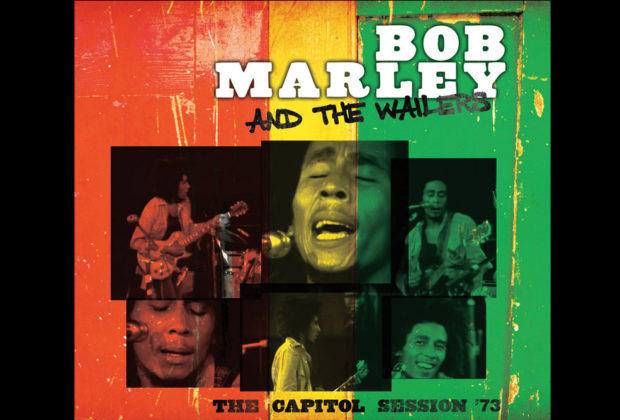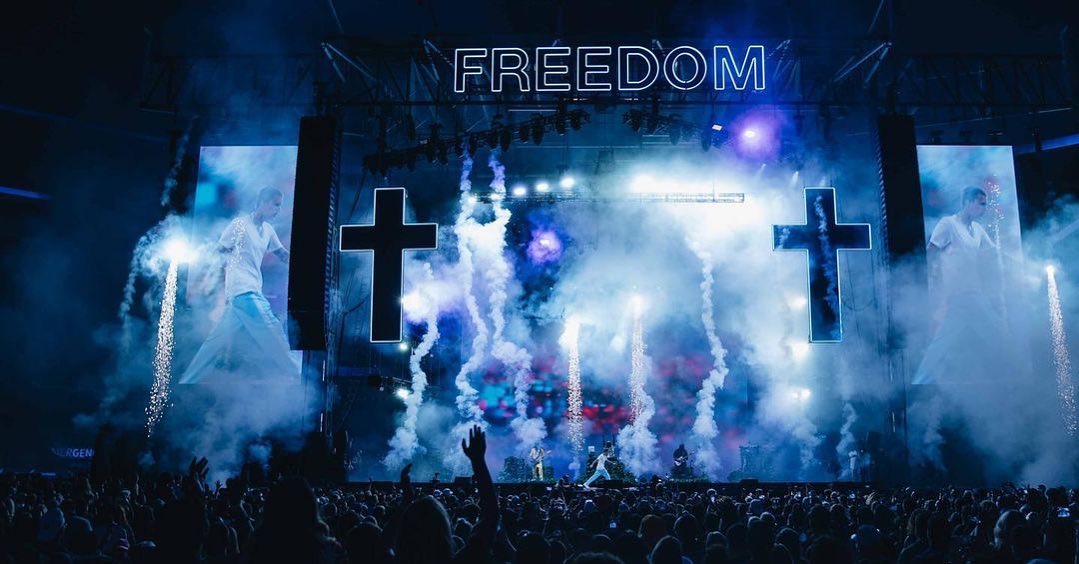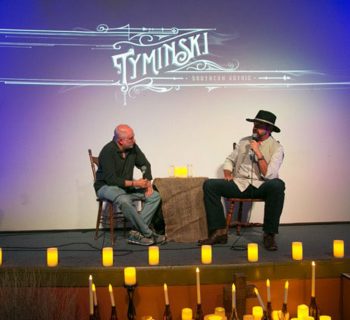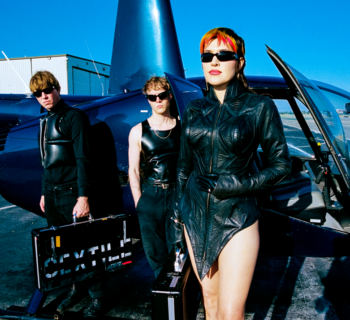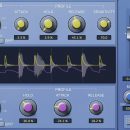The scene is Hollywood. October 1973. International reggae pioneers The Wailers were filmed in a closed door session at The Capitol Records Tower on October 24 by famed record producer Denny Cordell, who captured the band recording 12 songs. Shooting with four cameras and mixing “on the fly” to a colorized tape, this footage, has been painstakingly restored, resulting in an incredible presentation of this unseen live session.
On September 3, Tuff Gong and Mercury Studios are proud to present this concert (almost 50 years after it was recorded): Bob Marley And The Wailers: The Capitol Session ‘73 on DVD+CD, standalone CD, 2LP pressed on green marble vinyl, 2LP pressed on Rasta swirl vinyl (red, yellow and green – available exclusively at Sound of Vinyl), and digital formats.
This session at Capitol Studios represented a unique moment in the band’s career. Filmed 10 years after their formation, the Wailers already had several established hits through the ska and rocksteady eras. Gaining recognition stateside, including a few shows with Bruce Springsteen at Max’s Kansas City in New York City, they then went on to tour with Sly and the Family Stone, before they had been unceremoniously dumped from the tour. This led to the band (Bob Marley, Peter Tosh, Joe Higgs, Aston Barrett, Carlton Barrett, Earl “Wya” Lindo) making their way to Hollywood to do this session.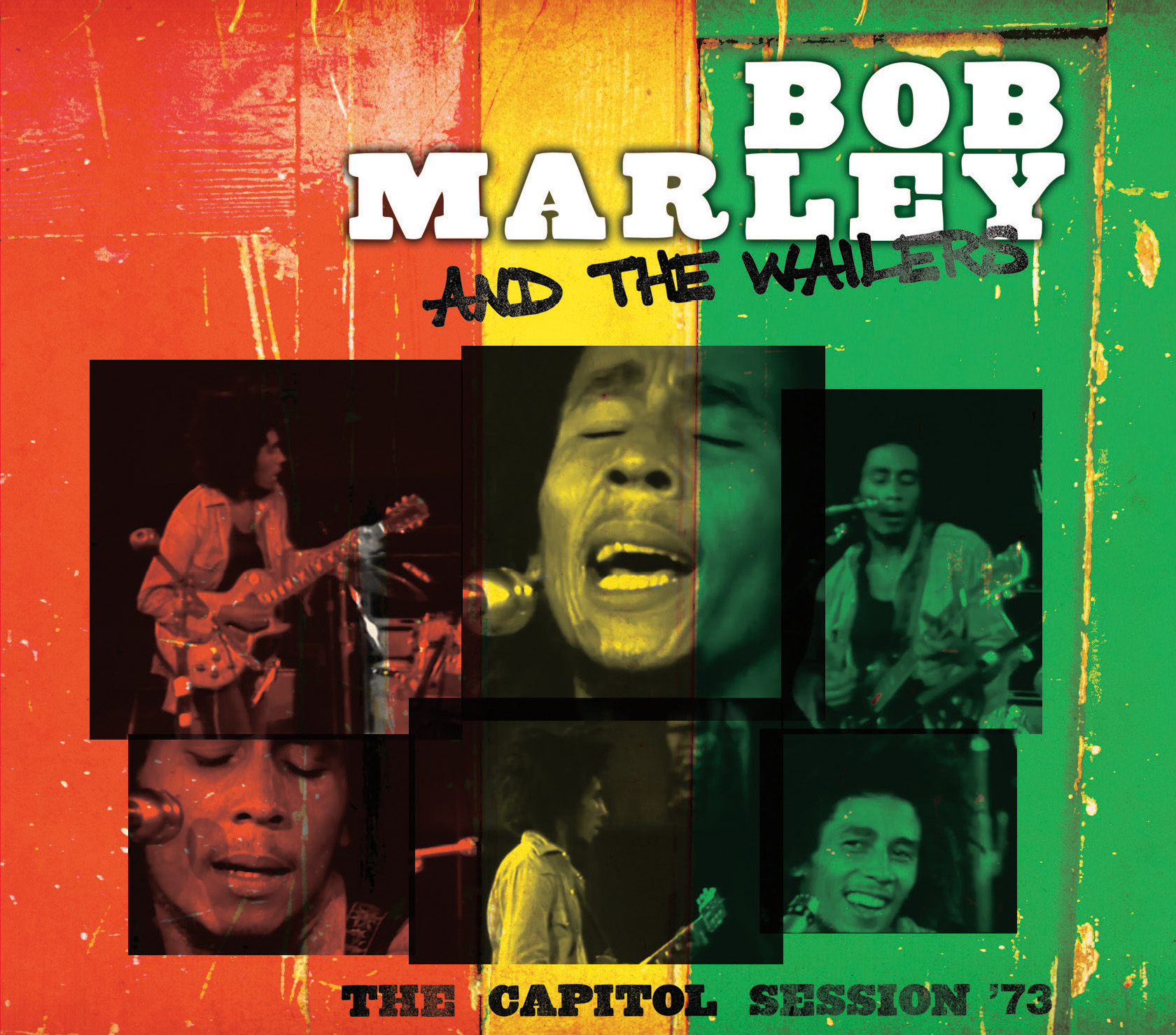
The footage from this session was considered lost until a freelance researcher uncovered a few frames. For over 20 years, archives and storage units from New York and London to San Diego were tracked down and searched to retrieve fragments of the film, until it was fully unearthed, restored, and remastered.
Evolving into a politically and socially charged unit after being inspired by the US Civil Rights movement, various African liberation efforts, and Rastafari, which Bob Marley and the Wailers studied from Rasta elders, their music reflected the soul and struggles of the era.
Track Listings: “You Can't Blame the Youth,” “Slave Driver,” “Burnin' and Lootin',” “Rastaman Chant,” “Duppy Conqueror,” “Midnight Raver,” “Put It On,” “Stop that Train,” “Kinky Reggae,” “Stir It Up,” “No More Trouble,” and “Get Up Stand Up.” DVD Bonus Tracks: “Duppy Conqueror” and “Rastaman Chant.
“In 1969, Jimmy Cliff “Wonderful World, Beautiful People,” ‘Israelites,’ from Desmond Dekker & The Aces, and earlier in the ‘60s, and Johnny Nash’s ‘Hold Me Tight’ had received lots of radio airplay and sold records in the Los Angeles market and Stateside areas,” remembered reggae scholar, author/deejay Roger Steffens.
“Nash had hired Bob Marley as a songwriter for his label and also a performer for JAD. So a lot of Marley songs had come out without anyone knowing who Bob Marley was. Nash struck later with ‘I Can See Clearly Now.’”
“Near the end of October, 1973 the Wailers came to Hollywood and rehearsed at Capitol Records,” specified Steffens.
“In the fall of 1973, Bob Marley and the Wailers were in inner turmoil. A few months earlier, co-founder Bunny Wailer, who had been raised as Bob's brother since his father moved in with Bob's mother in 1966, left the group. He was upset that Island Records' chief, Chris Blackwell, told the group he had signed in late 1972, that he wanted them to tour ‘freak clubs.’
“As I outlined in my recent book, So Much Things to Say: The Oral History of Bob Marley, Bunny's response to that suggestion was to ask Blackwell what he meant by freak clubs. ‘He said, well, you know, clubs where gay guys and gals, gals meet gals and guys meet guys and freak out. Drug business, all kind of stuff - freak. I said, how you want to take us all in that direction? Why you want draw us down in dem kind of things? We is Rasta, we no stand for dem things.’ And Bunny quit the group on the spot.
“Coming off the critical success of their international debut on Island, Catch A Fire, Blackwell wanted them to tour America for their follow up Burnin' which would prove to be the trio's final work together.
“To replace Bunny, Bob invited the group's initial teacher, the great Joe Higgs, known as the father of reggae music because of his early tutoring of many of the music's initial stars. Higgs knew the harmonies and could play percussion, so he fit in perfectly as he rehearsed at the Capitol Records Tower in Hollywood that October. The taping was October 23, 1973.
“Outside the famous tower sat a mobile mixing studio, wherein sat a white American, harmonica player and fine artist, Lee Jaffe, who experimented with a brand-new special effects board while the rehearsal went on. Bootleg tapes of the event have circulated since the '70s in collectors' circles. But legal difficulties remained for decades.
“Ownership was claimed by Denny Cordell, who founded Shelter Records, and was championed throughout this period by a tireless British entrepreneur Martin Disney, who was largely responsible for its ultimate release,” reinforced Roger.
“Peter Tosh, who would leave the group too a few weeks after this film was made, is seen in an amazing duet with Bob on ‘Get Up Stand Up,’ where he sings some different lyrics as if to trip Bob up. But this final alignment, after ten years together, shows the tightness of their arrangements and how Bob was desperate to keep the Wailers' sound alive. It was Bob who wrote the song, but he gave a verse to Peter to create so that he could share in the writers' royalties. It was Tosh who wrote about being sick of the ‘bullshit game,’ and the mythology surrounding Jesus' name,” added Steffens.
“All in all, this refreshing new look at the Wailers' final days together will shed a welcome light on the power of their creations. I was angry for a long time that Chris almost took joy in the fact that he helped break up the group. Over the years I've begun to think differently - imagine the world without Bunny's Blackheart Man or Peter's Equal Rights. We got three times the music we would have had if the group had not broken up. The Sheltervision session shows what we lost.”
I’ve been waiting almost 50 years to hear and own an official retail copy of these landmark recordings of the Wailers first visit to Hollywood.
A publicist, Michael Ochs, who I knew from his 1969-1972 PR department tenure at Columbia Records in Hollywood, was hired by record producer and talent scout Denny Cordell to introduce the The Harder they Come Perry Henzell-directed movie starring Jimmy Cliff and the movie’s soundtrack album. Michael wrote for Melody Maker in 1972. We both attended a handful of regional June 1972 concerts by the Rolling Stones after the release of Exile on Main Street.
Ochs mailed a copy of The Harder They Come LP, a press kit and a mango fruit, all contained in a burlap bag that arrived to my college dormitory at Zura Hall at San Diego State University. I seem to recall the mailing sticker came from Mango/Capitol Records.
In 1972 I had only written a couple of record reviews at the time for The Hollywood Press. I attempted to generate a review in The Daily Aztec and was rejected. The hypnotic pulse of the sound of reggae on this vinyl was captivating. I needed to see this movie.
In November 1972 I saw The Harder They Come debut in Hollywood at Grauman’s Chinese Theatre, where it screened as part of Filmex, the Los Angeles International Film Exposition. The place was packed and the audience loved it. I have a faint memory of Roger Corman securing domestic distribution via his company New World Pictures.
The landscape and musical climate of the United States was altered by the December 26th -December 31, 1972 local premiere of the movie The Harder They Come when it was booked at the Nu-Art Theater in Westwood, California.
“Denny Cordell called me in 1972 and wanted me to do the publicity for the soundtrack,” explained Michael Ochs to me in a July 2021 interview.
“I saw it at Filmex, and loved the soundtrack album. I fell in love with reggae. Denny and Leon Russell were partners in Shelter Records and Leon spent a lot of money on a remote recording truck. I was at the Wailers taping in October at the Capitol studio which was fun. It was like a big rehearsal leading to a real performance.
“The rock press loved the movie and the soundtrack. It was too unique for AM and FM radio. Black radio programmers were not receptive at all. At the time there was a dirth of originality. When this happens the media tend to go to roots music, like blues. Reggae was the light at the end of the tunnel. It was important to promote it. At that time I wasn’t sure if Toots [Hibbert] and the Maytals or Bob Marley was going to be the leader of the movement.
“Denny then hired me for the Shelter label. He agreed to pay a salary, an office and a secretary. J.J. Cale and Phoebe Snow were two of the artists I worked with.
Denny agreed to fly me down to Kingston if I could get a story in Rolling Stone so I called my friend Michael Thomas and he sold it to Stone. So RS paid for Michael to come from London to do the story. Chris Blackwell loaned us one of his houses for us to stay in - Me, Michael and photographer Arthur Gorson.
Robert Christgau didn't stay there but came at the same time to do a 5-part story for Newsday, a Long Island paper. Michael and Arthur went into Trenchtown to interview Marley but they were the only 2 that were allowed in. For the rest of the time we were down there, different reggae artists, including Toots were sent to the house to talk to Michael for the story.”
There was also a young college student in 1973 named James Cushing newly enrolled at U.C. Santa Cruz who emerged as the Pied Piper of reggae in Northern California.
I first met Cushing in 1968 in Westwood at Senator Eugene McCarthy’s headquarters for his 1968 United States presidential run. During 1972, Cushing, my brother Kenneth and I attended the debut of the Mahavishnu Orchestra at the Whisky a Go Go.
“April 1973. All US troops are ‘fully withdrawn’ from Vietnam, abortion is legal, the trial of the Watergate burglars is front-page news, and in New York, the 110-story World Trade Center has just opened,” Dr. James Cushing emailed me in July 2021.
“In ultra-mellow Santa Cruz, CA, serial murderer Ed Kemper, who has killed and mutilated three people known to me personally, has just turned himself in to police, and the sense of relief on campus is as tangible as the bark on the redwood trees.
I’m a sophomore at College V (now Porter College), living with my girlfriend in B-dorm, where pot is $15 an ounce, LSD is $2 a hit, and everyone’s young and sexually active.
“You can tell, because everyone’s stereo is playing something new and provocative like last month’s Pink Floyd release, Dark Side of the Moon, or the brand-new one by this new English guy David Bowie, Alladin Sane. I’m writing record and concert reviews for the campus paper The City on a Hill Press, and Capitol has been generous enough to put me on their rock mailing list, so I get all their new releases, like Pink Floyd, and people come to my dorm room to check them out.
“Well, Dark Side of the Moon was cool, but Capitol was distributing Chris Blackwell’s Island imprint, and sent campus critics another record that season by a new group called The Wailers — Catch a Fire, it was called, with a clever hinged cover resembling a Zippo lighter, and music that nobody in that building had ever heard before.
“The players were all black, but their sound wasn’t ‘soul’ or ‘funk’ in the Motown / Stax / James Brown / Aretha sense, and it wasn’t anything like Jimi or Sly & the Family Stone. The bass and guitars and drums were all plenty loud, but it wasn’t “rock” either.
“The word ‘reggae’ was used in Capitol promotional material, but I didn’t know how to pronounce it — soft ‘g’ or hard? — and at the level that mattered most, that was all right.
“Marley’s sound was just the thing we needed after weeks of local terror and political uncertainty: something sexy and relaxing, thoughtful and physical, totally new and totally cool.
“For most of that quarter, mid-April to mid-June 1973, Catch a Fire was the #1 party album in my part of B-dorm, with ‘Kinky Reggae’ the one that got everyone moving (‘a candy tar / all over his chocolate bar,’ ‘she had brown sugar / all over her booga-wooga’).
“I believe that place on the time-line qualifies us as the first reggae-heads in Santa Cruz. Residents of that floor in that building that quarter will likely remember these parties well. Stir it up, midnight ravers!”
“Then Michael Thomas’s wrote an article in June 1973 in Rolling Stone on the Wailer’s album Catch a Fire,” emphasized Roger Steffens.
“It was six months after the movie had been released and there was a buzz with the movie playing every weekend on the midnight movie circuit. It was a seismic event that further changed the complexion of music in Los Angeles.”
And everybody I knew in Hollywood had a copy of the debut Wailers’ Catch a Fire.
On the day Duke Ellington died, May 24, 1974, I encountered Johnny Nash in the lobby of Columbia Records on Sunset Blvd. Johnny was enjoying success stemming from his 1972 hit single, “I Can See Clearly Now.”
We had a very brief chat. He nodded when I mentioned he had co-written a song, “Some of You Love,” with record producer Phil Spector in 1961 when he was inked to ABC-Paramount Records. Spector first met Nash, and songwriter Tommy Boyce, during their Army physical examination.
As Johnny and I left the elevator ride I wished I would have reminded myself to tell Nash how much I loved his song “What Kind of Love Is This?” Joey Dee and the Starliters had cut the tune in 1962 for the Columbia picture Two Tickets to Paris.
I eventually saw/witnessed Bob Marley & the Wailers eight times during 1975-1979. First time was July 13, 1975 at the Roxy Theater in West Hollywood.
I interviewed the group once in 1976 for Melody Maker. Our conversation was held in such a smoke-filled room in West Hollywood at the Island Records office in California on Sunset Blvd., I forgot to turn the tape machine on!
John Lennon and Yoko Ono attended a Wailers’ May 16, 1976 Roxy show. While waiting for their car to arrive in the parking lot of the adjacent Rainbow Bar & Grill, I thanked John for introducing me to reggae and blue beat music that he touted in music weeklies and radio interviews.
On July 22, 1978 I went to see the Wailers at The Starlight Bowl Ampitheatre in Burbank. A few reporters were given tickets and backstage passes. At the time press coverage in the US was important for the Wailers and Marley’s reggae mission.
I watched the concert from the wings standing the whole evening with Mick Jagger, holding daughter Jade in his arms. Mick still happily managed to pass some ganja to our circle that included Peter Tosh, who was opening the next day for the Rolling Stones at Anaheim Stadium.
Before the awe-inspiring evening concluded, a sweaty Bob Marley ran to our area of the venue, brushing up against me on his way to talk to Peter, who then joined him for a surprise appearance during “Get Up, Stand Up.”
Tosh later told Roger Steffens, ‘Mi slap Bob’s hand and him say, ‘Bwoi, de Pope feel dat one.’
And three days later the Pope died.
Bob Marley has been inducted into the Rock and Roll Hall of Fame (1994) and ASCAP Songwriters Hall of Fame (2010).
Harvey Kubernik is the author of 20 books, including Canyon Of Dreams: The Magic And The Music Of Laurel Canyon and Turn Up The Radio! Rock, Pop and Roll In Los Angeles 1956-1972.
Sterling/Barnes and Noble in 2018 published Harvey and Kenneth Kubernik’s The Story Of The Band: From Big Pink To The Last Waltz. For October 2021 the duo has written Jimi Hendrix: Voodoo Child for the publisher.
Otherworld Cottage Industries in 2020 published Harvey’s book, Docs That Rock, Music That Matters, featuring interviews with D.A. Pennebaker, Chris Hegedus, Albert Maysles, Murray Lerner, Morgan Neville, Curtis Hanson, Michael Lindsay-Hogg, Andrew Loog Oldham, Eddie Kramer, Dick Clark, Ray Manzarek, John Densmore, Robby Krieger, Christopher M. Allport, Travis Pike, Allan Arkush, and David Leaf, among others.
Kubernik’s writings are in the anthologies The Rolling Stone Book Of The Beats and Drinking With Bukowski.
Harvey wrote the liner note booklets to the CD re-releases of Carole King’s Tapestry, Allen Ginsberg’s Kaddish, Elvis Presley The ’68 Comeback Special and the Ramones’ End of the Century. Kubernik penned the liner notes to the November 2021 National Record Store Day Drops Lou Adler-produced release, A Combination of the Two, by Big Brother & the Holding Company featuring Janis Joplin culled from the 1967 Monterey International Pop Festival. Harvey is currently writing a female-themed music manuscript Sisters In Song.
During 2020 Harvey Kubernik served as a Consultant on the 2-part documentary television series Laurel Canyon: A Place in Time directed by Alison Ellwood that premiered on EPIX television channel.

